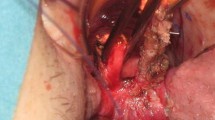Abstract
PURPOSE: Anal sphincter spasm is believed to play an important role in pain after hemorrhoidectomy. We tested a different form of nitroglycerin: the Nitroderm TTS® band. We investigated its efficacy on posthemorrhoidectomy pain and the relation between pain and anal resting pressure measured preoperatively and postoperatively. METHODS: Thirty-eight hemorrhoid patients were divided into two groups: those with high anal resting pressure were classified as group A (n=24) and those with low anal resting pressure were classified as group B (n=14). After hemorrhoidectomy, Nitroderm TTS® bands were placed into the anal canal in half of the patients in groups A and B (groups A-1 and B-1) and not in the remaining half (groups A-2 and B-2). Anal resting pressure measurement was repeated at the first day and third month postoperatively. Postoperative pain was assessed by linear analog scale, and analgesic consumption was recorded. RESULTS: Preoperative anal resting pressure was 112.0 (range, 95–140) cm H2O in group A-1 and 110.6 (range, 96–138) cm H2O in group A-2. The difference was insignificant. However, on the first postoperative day, anal resting pressures were 88.7 (range, 75–115) and 110.9 (range, 92–135) cm H2O (P=0.0001), and at the third month, they were 76.5 (range, 70–100) and 78.0 (range, 70–105) cm H2O, respectively (P=0.690). Postoperative pain scores were significantly lower in group A-1 than group A-2 (P=0.0001). In the low-pressure groups (B-1 and B-2), anal resting pressures before surgery, on the first postoperative day, and at the third month postoperatively were 70.4 (range, 56–76), 67.4 (range, 50–75), and 67.2 (range, 55–74) cm H2O in group B-1 and 69.8 (range, 58–76), 70.2 (range, 60–76), and 68.4 (range, 60–74) cm H2O in group B-2. The differences were insignificant (P≥0.660). The differences between pain scores in these groups were also insignificant (P≥0.160). CONCLUSION: Nitroderm TTS® bands effectively reduced anal resting pressure and relieved pain in patients with high preoperative anal resting pressure.
Similar content being viewed by others
References
Patel N, O'Connor T. Suture haemorrhoidectomy: a day-only alternative. Aust N Z J Surg 1996;66:830–1.
Goldstein ET, Williamson PR, Larach SW. Subcutaneous morphine pump for postoperative hemorrhoidectomy pain management. Dis Colon Rectum 1993;36:439–46.
O'Hara DA, Fragen RJ, Kinzer M. Ketorolac tromethamine as compared with morphine sulphate for treatment of postoperative pain. Clin Pharmacol Ther 1987;41:556–61.
Weisbrodot NW, Sussman SE, Steawart JJ. Effect of morphine sulphate on intestinal transit and myoelectric activity of the small intestine of the rat. J Pharmacol Exp Ther 1980;214:333–8.
Hiltunen KM, Matikainen M. Anal manometric findings in symptomatic hemorrhoids. Dis Colon Rectum 1985;28:807–9.
Arabi Y, Alexander-Williams J, Keighley MR. Anal pressures in hemorrhoids and anal fissure. Am J Surg 1977;134:608–10.
Deutsch AA, Moshkovitz M, Nudelman I, Dinari G, Reiss R. Anal pressure measurements in the study of hemorrhoid etiology and their relation to treatment. Dis Colon Rectum 1987;30:855–7.
Ho YH, Seow-Choen F, Low JY, Tan M, Leong AP. Randomised controlled trial of trimebutine (anal sphincter relaxant) for pain after haemorrhoidectomy. Br J Surg 1997;84:377–9.
Loder PB, Kamm MA, Nicholls RJ, Phillips RK. “Reversible chemical sphincterotomy” by local application of glyceryl trinitrate. Br J Surg 1994;81:1386–9.
Asfar SK, Juma TH, Ala-Edeen T. Hemorrhoidectomy and sphincterotomy: a prospective study comparing the effectiveness of anal stretch and sphincterotomy in reducing pain after hemorrhoidectomy. Dis Colon Rectum 1988;31:181–5.
Roe AM, Bartolo DC, Vellacott KD, Locke-Edmunds J, Mortensen NJ. Submucosal versus ligation excision haemorrhoidectomy: a comparison of anal sensation, anal sphincter manometry and postoperative pain and function. Br J Surg 1987;74:948–51.
Clark WG, Brater DC, Johnson AR. Antianginal drugs. In: Goth's Medical Pharmacology. 13th ed. St Louis: Mosby-Year Book, 1992:440–8.
Fung HL, Chung SJ, Bauer JA, Chong S, Kowaluk EA. Biochemical mechanism of organic nitrate action. Am J Cardiol 1992;70:4B-10B.
Manookian CM, Fleshner P, Moore B, Teng F, Cooperman H, Sokol T. Topical nitroglycerin in the management of anal fissure: an explosive outcome! Am Surg 1998;64:962–4.
Bogaert MG. Clinical pharmacokinetics of glyceryl trinitrate following the use of systemic and topical preparations. Clin Pharmacokinet 1987;12:1–11.
Hiltunen KM, Matikainen M. Anal dilatation, lateral subcutaneous sphincterotomy and haemorrhoidectomy for the treatment of second and third degree haemorrhoids: a prospective randomized study. Int Surg 1992;77:261–3.
Murie JA, Sim AJ, Mackenzie I. Rubber band ligation versus haemorrhoidectomy for prolapsing haemorrhoids: a long term prospective clinical trial. Br J Surg 1982;69:536–8.
MacRae HM, McLeod RS. Comparison of hemorrhoidal treatment modalities: a meta-analysis. Dis Colon Rectum 1995;38:687–94.
Lewis AA, Rogers HS, Leighton M. Trial of maximal anal dilatation, cryotherapy and elastic band ligation as alternatives to haemorrhoidectomy in the treatment of large prolapsing haemorrhoids. Br J Surg 1983;70:54–6.
Goligher JC, Graham NG, Clark CG, De Dombal FT, Giles G. The value of stretching the anal sphincters in the relief of post-haemorrhoidectomy pain. Br J Surg 1969;56:859–61.
Eisenhammer S. Internal anal sphincterotomy plus free dilatation versus anal stretch with special criticism of the anal stretch procedure for hemorrhoids: the recommended modern approach to hemorrhoid treatment. Dis Colon Rectum 1974;17:493–522.
Mathai V, Ong BC, Ho YH. Randomized controlled trial of lateral internal sphincterotomy with haemorrhoidectomy. Br J Surg 1996;83:380–2.
Sun WM, Read NW, Shorthouse AJ. Hypertensive anal cushions as a cause of the high anal canal pressures in patients with haemorrhoids. Br J Surg 1990;77:458–62.
Ho YH, Seow-Choen F, Goh HS. Haemorrhoidectomy and disordered rectal and anal physiology in patients with prolapsed haemorrhoids. Br J Surg 1995;82:596–8.
el-Gendi MA, Abdel-Baky N. Anorectal pressure in patients with symptomatic hemorrhoids. Dis Colon Rectum 1986;29:388–91.
Schouten WR, van Vroonhoven TJ. Lateral internal sphincterotomy in the treatment of hemorrhoids: a clinical and manometric study. Dis Colon Rectum 1986;29:869–72.
Author information
Authors and Affiliations
About this article
Cite this article
Coskun, A., Duzgun, S.A., Uzunkoy, A. et al. Nitroderm TTS® band application for pain after hemorrhoidectomy. Dis Colon Rectum 44, 680–685 (2001). https://doi.org/10.1007/BF02234566
Issue Date:
DOI: https://doi.org/10.1007/BF02234566




